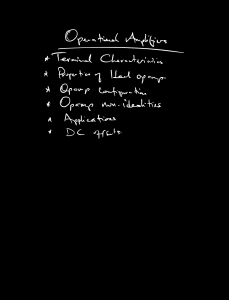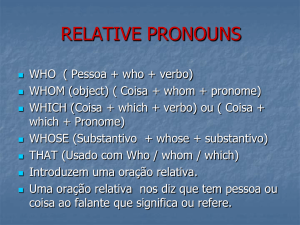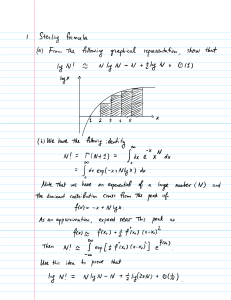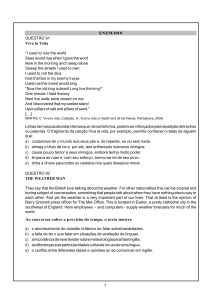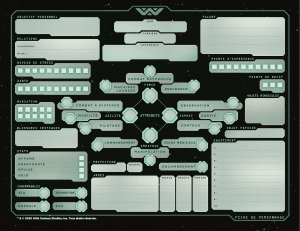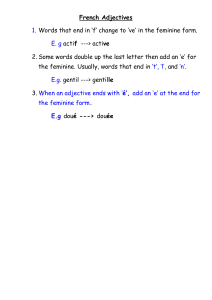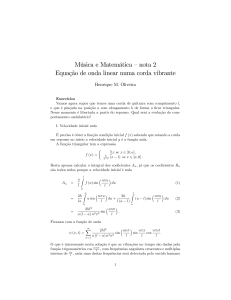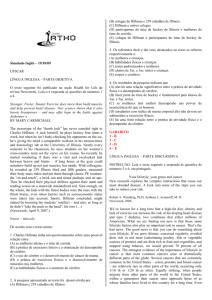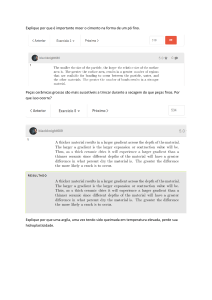OlÃmpiadasComplexos
advertisement
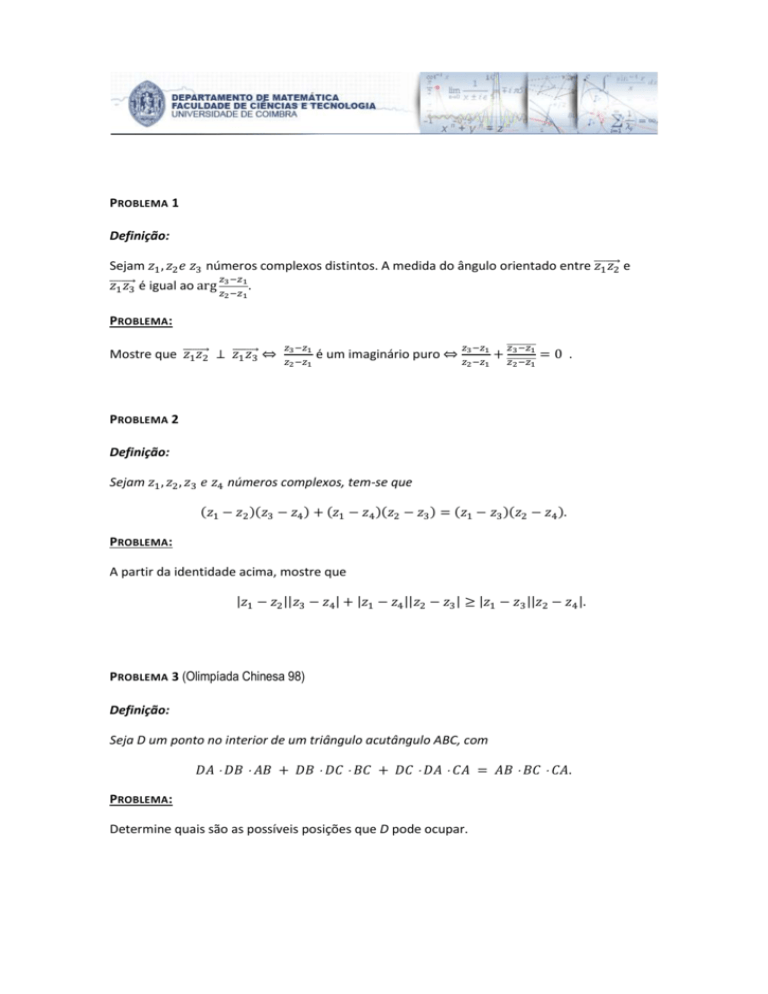
PROBLEMA 1 Definição: Sejam 𝑧1 , 𝑧2 𝑒 𝑧3 números complexos distintos. A medida do ângulo orientado entre 𝑧⃗⃗⃗⃗⃗⃗⃗⃗ 1 𝑧2 e 𝑧 −𝑧 3 1 𝑧⃗⃗⃗⃗⃗⃗⃗⃗ 1 𝑧3 é igual ao arg 𝑧 −𝑧 . 2 1 PROBLEMA: Mostre que 𝑧⃗⃗⃗⃗⃗⃗⃗⃗ ⃗⃗⃗⃗⃗⃗⃗⃗ 1 𝑧2 ⊥ 𝑧 1 𝑧3 ⇔ 𝑧3 −𝑧1 𝑧2 −𝑧1 é um imaginário puro ⇔ 𝑧3 −𝑧1 𝑧2 −𝑧1 ̅̅̅̅̅̅̅̅̅ 𝑧 −𝑧 𝑧2 −𝑧1 3 1 + ̅̅̅̅̅̅̅̅̅ =0 . PROBLEMA 2 Definição: Sejam 𝑧1 , 𝑧2 , 𝑧3 𝑒 𝑧4 números complexos, tem-se que (𝑧1 − 𝑧2 )(𝑧3 − 𝑧4 ) + (𝑧1 − 𝑧4 )(𝑧2 − 𝑧3 ) = (𝑧1 − 𝑧3 )(𝑧2 − 𝑧4 ). PROBLEMA: A partir da identidade acima, mostre que |𝑧1 − 𝑧2 ||𝑧3 − 𝑧4 | + |𝑧1 − 𝑧4 ||𝑧2 − 𝑧3 | ≥ |𝑧1 − 𝑧3 ||𝑧2 − 𝑧4 |. PROBLEMA 3 (Olimpíada Chinesa 98) Definição: Seja D um ponto no interior de um triângulo acutângulo ABC, com 𝐷𝐴 𝐷𝐵 𝐴𝐵 + 𝐷𝐵 𝐷𝐶 𝐵𝐶 + 𝐷𝐶 𝐷𝐴 𝐶𝐴 = 𝐴𝐵 𝐵𝐶 𝐶𝐴. PROBLEMA: Determine quais são as possíveis posições que D pode ocupar. PROBLEMA 4 (Olimpíada Universitária Húngara 1995) Definição 1: PROBLEMA São dados 𝑛 pontos na circunferência unitária de modo que o produto das distâncias de qualquer ponto da circunferência a estes pontos é menor ou igual a 2. Prove que os pontos são vértices de um 𝑛–ágono regular. PROBLEMA 5 (IMO 75) Definição PROBLEMA Determine se existem ou não 1975 pontos sobre a circunferência unitária tais que a distância entre quaisquer dois é um número racional. PROBLEMA 6 (IMO 63) Definição: PROBLEMA Todos os ângulos internos de um n-ágono são iguais e seus lados satisfazem a relação a1 a 2 ... a n . Prove que a1 a 2 ... a n . SOLUÇÃO PROBLEMA 1. Sejam ⃗⃗⃗⃗⃗⃗⃗⃗ 𝑧1 𝑧2 e 𝑧⃗⃗⃗⃗⃗⃗⃗⃗ 1 𝑧3 dois vetores perpendiculares então a medida do ângulo orientado entre eles 𝜋 é de 2 , ou seja, 𝜋 arg(𝑧2 − 𝑧1 ) = arg(𝑧4 − 𝑧3 ) ± 2 , que é equivalente a 𝑧3 −𝑧1 𝑧2 −𝑧1 Assim, = 𝜆𝑖 para algum 𝜆 ∈ ℝ. 𝑧3 − 𝑧1 é um imaginário puro 𝑧2 − 𝑧1 e, por isso, também se pode escrever da forma ̅̅̅̅̅̅̅̅̅̅̅̅̅ 𝑧3 − 𝑧1 𝑧3 − 𝑧1 ( )=− 𝑧2 − 𝑧1 ⇔ 𝑧2 − 𝑧1 𝑧3 − 𝑧1 ̅̅̅̅̅̅̅̅̅ 𝑧3 − 𝑧1 + = 0. 𝑧2 − 𝑧1 ̅̅̅̅̅̅̅̅̅ 𝑧2 − 𝑧1 SOLUÇÃO PROBLEMA 2. SOLUÇÃO PROBLEMA 3. Sejam a, b, c, e 0 as coordenadas complexas de A, B, C e D, respetivamente. Temos, então 𝐷𝐴 𝐷𝐵 𝐴𝐵 + 𝐷𝐵 𝐷𝐶 𝐵𝐶 + 𝐷𝐶 𝐷𝐴 𝐶𝐴 = 𝐴𝐵 𝐵𝐶 𝐶𝐴 que a b (b a) b c (c b) c a (a c) (b a)(c b)(a c) (*) Como ab(b a) bc(c b) ca(a c) (b a)(c b)(a c) , sendo w1 ab (b a), w2 bc(c b), w3 ca(a c), (*) w1 w2 w3 w1 w2 w3 e portanto, w1, w2, w3 estão alinhados. Assim, existem reais positivos e tais que w1 w2 ab(b a) bc(c b) a (b a) c(c b) a bc , b ac w1 w3 ab(b a) ca(a c) b(b a) c(a c) isto é, A C B 180 A DB e, analogamente, A B C 180 A DC e B A C 180 B DC. O único ponto D no interior de um triângulo acutângulo que satisfaz essas condições é o ortocentro. SOLUÇÃO PROBLEMA 4. Considere a circunferência centrada na origem e sejam z1, z2, …, zn os números complexos que representam os pontos. Podemos assumir que (1) n z1 z 2 ...z n 1 . Considere ainda o seguinte polinômio p( w) ( w z1 )(w z 2 )...(w z n ) w n a1 w n1 ... a n1 w 1 w n Q (w) 1 Então p(z) é o produto das distâncias do ponto representado pelo número complexo z aos pontos dados . Logo, se z é um número complexo de módulo 1, então p(z)| 2. Sejam w1, w2,… wn as raízes n-ésimas da unidade. Sabe-se que w1k w2k ... wnk 0 para todo k = 1, 2,…,n – 1. Portanto Q( w1 ) Q( w2 ) ... Q( wn ) 0. Se Q(w) não é identicamente nulo, então, para algum j, Q (wj) é diferente de zero e tem parte real não negativa, pois Q(0) = 0 e Q tem no máximo n – 1 raízes. Consequentemente, p( w j ) 2 Q ( w j ) 2 , uma contradição. Desta forma o polinômio Q é identicamente nulo e p(z) = zn + 1. As raízes z1, z2, …, zn do polinômio p(z) formam um n-ágono regular. SOLUÇÃO PROBLEMA 5. Let x be the angle cos-14/5, so that cos x = 4/5, sin x = 3/5. Take points on the unit circle at angles 2nx for n integral. Then the distance between the points at angles 2nx and 2mx is 2 sin(n - m)x. The usual formula, giving sin(n - m)x in terms of sin x and cos x, shows that sin(n - m)x is rational. So it only remains to show that this process generates arbitarily many distinct points, in other words that x is not a rational multiple of pi. This is quite hard. There is an elegant argument in sections 5 and 8 of Hadwiger et al, Combinatorial geometry in the Plane. But we can avoid it by observing that there are only finitely many numbers with are nth roots of unity for n <= 2 x 1975, whereas there are infinitely many Pythagorean triples, so we simply pick a triple which is not such a root of unity. SOLUÇÃO PROBLEMA 6. For n odd consider the perpendicular distance of the shortest side from the opposite vertex. This is a sum of terms ai x cosine of some angle. We can go either way round. The angles are the same in both cases, so the inequalities give that a1 = an-1, and hence a1 = ai for all i < n. We get a1 = an by repeating the argument for the next shortest side. The case n even is easier, because we take a line through the vertex with sides a1 and an making equal angles with them and look at the perpendicular distance to the opposite vertex. This gives immediately that a1 = an. SOLUÇÃO PROBLEMA 5. Let x be the angle cos-14/5, so that cos x = 4/5, sin x = 3/5. Take points on the unit circle at angles 2nx for n integral. Then the distance between the points at angles 2nx and 2mx is 2 sin(n - m)x. The usual formula, giving sin(n - m)x in terms of sin x and cos x, shows that sin(n - m)x is rational. So it only remains to show that this process generates arbitarily many distinct points, in other words that x is not a rational multiple of pi. This is quite hard. There is an elegant argument in sections 5 and 8 of Hadwiger et al, Combinatorial geometry in the Plane. But we can avoid it by observing that there are only finitely many numbers with are nth roots of unity for n <= 2 x 1975, whereas there are infinitely many Pythagorean triples, so we simply pick a triple which is not such a root of unity. SOLUÇÃO PROBLEMA 6. For n odd consider the perpendicular distance of the shortest side from the opposite vertex. This is a sum of terms ai x cosine of some angle. We can go either way round. The angles are the same in both cases, so the inequalities give that a1 = an-1, and hence a1 = ai for all i < n. We get a1 = an by repeating the argument for the next shortest side. The case n even is easier, because we take a line through the vertex with sides a1 and an making equal angles with them and look at the perpendicular distance to the opposite vertex. This gives immediately that a1 = an. PROBLEMA 5 (IMO 75) Definição PROBLEMA Determine se existem ou não 1975 pontos sobre a circunferência unitária tais que a distância entre quaisquer dois é um número racional. PROBLEMA 6 (IMO 63) Definição: PROBLEMA Todos os ângulos internos de um n-ágono são iguais e seus lados satisfazem a relação a1 a 2 ... a n . Prove que a1 a 2 ... a n .
